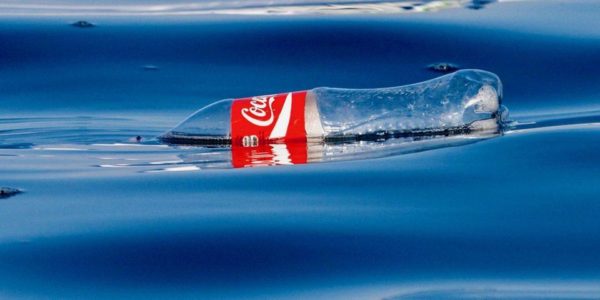

A plastic Coke bottle floats in the Pacific Ocean. GETTY IMAGES
Every person reading this has used a plastic bottle, many of whom likely used one in the past day or week. Plastic, in the recent decades, has become a staple of convenience and a modern lifestyle. The surge in plastic bottle use has accompanied a desire for bottled water as Asia has modernized its lifestyle.
Several recent reports indicate the dire global situation associated with the world’s plastic use. Two statistics jump out immediately. One, that globally humans buy a million plastic bottles per minute. The second, 91% of all plastic is not recycled. On top of that, it is estimated that over half a trillion plastic bottles will be sold in 2020.
This presents an overwhelming challenge in responding to an exponential increase in recyclable yet un-recycled products.
Plastic bottles are commonly made from polyethylene terephthalate (Pet), which take 400 years to naturally decompose, yet is highly recyclable. On geologic timescales, 400 years is not significant and one may make the claim that we can just wait it out until the bottles naturally decompose. However, there are two significant issues with this. There are no signs of decreasing plastic use, hence the plastic decomposition clock will constantly be reset. Secondly, and more importantly, we must understand how this increase in plastic waste globally will impact other systems and their function.
Most plastic, bottles included, ends up in either the ocean or in a landfill. Let’s look at the potential impacts of storing vast amounts of plastic waste in both locations.
Plastic In The Ocean
It is estimated that by 2050 the ocean will contain more plastic by weight than fish. The plastic that finds its way into the oceans inevitably will pose a risk of ingestion by sea birds, fish, marine mammals, etc. It’s not uncommon to see articles of sea life found dead with significant amounts of plastic in their stomach.
While these impacts may seem individualized and uncorrelated with the sushi you eat at your local sushi shop, they are not. Recent studies point to increasing amounts of plastic within the seafood you and I eat on a regular basis. A recent study by Ghent University in Belgium, for example, found that people who regularly eat seafood ingest up to 11,000 tiny pieces of plastic each year. Another study by Plymouth University found that one-third of all fish caught in the UK contained tiny pieces of plastic.
A tool developed on Plastic Drift shows you where plastic is likely to end up in the oceans when the user chooses an initiation point. This drives home the global impact of a coke bottle leaving the shores of New York on western Europe and Africa.
#IsThisYours?

A simple question, but an important one
That’s what we’re asking the brands whose plastic pollution is choking our planet. We’re gathering evidence that single-use plastic packaging is ending up where it shouldn’t be, and holding the corporate polluters accountable. Get involved.
Here’s how to help
Photograph:
Take a photo or video of the next piece of branded plastic waste you see outside near your house, school, beach, nature trail, street, shopping or other place.
Expose:
Post the photo or video to social media, tag the brand (ex: @cocacola), and use the hashtag #IsThisYours? to let these companies know we’re calling them out for polluting the planet with throwaway plastic.
Share:
Challenge three or more friends to do the same. The more people who take part, the more impact we can have.
By tagging the brands responsible, we’ll let executives at Coca-Cola, PepsiCo, Nestlé, Unilever, Procter & Gamble, Starbucks, McDonald’s, and many other companies know that we no longer want their products served in single-use plastic packaging.
Tell these companies it’s time to #BreakFreeFromPlastic!
more recommended stories
 Fentanyl Seizures at Border Continue to Spike, Making San Diego a National Epicenter for Fentanyl Trafficking
Fentanyl Seizures at Border Continue to Spike, Making San Diego a National Epicenter for Fentanyl TraffickingFentanyl Seizures at Border Continue to.
 Utah Man Sentenced for Hate Crime Attack of Three Men
Utah Man Sentenced for Hate Crime Attack of Three MenTuesday, August 8, 2023 A.
 Green Energy Company Biden Hosted At White House Files For Bankruptcy
Green Energy Company Biden Hosted At White House Files For BankruptcyAug 7 (Reuters) – Electric-vehicle parts.
 Former ABC News Reporter Who “Debunked” Pizzagate Pleads Guilty of Possessing Child pδrn
Former ABC News Reporter Who “Debunked” Pizzagate Pleads Guilty of Possessing Child pδrnFriday, July 21, 2023 A former.
 Six Harvard Medical School and an Arkansas mortuary Charged With Trafficking In Stolen Human Remains
Six Harvard Medical School and an Arkansas mortuary Charged With Trafficking In Stolen Human RemainsSCRANTON – The United States.
 Over 300 People Facing Federal Charges For Crimes Committed During Nationwide Demonstrations
Over 300 People Facing Federal Charges For Crimes Committed During Nationwide DemonstrationsThe Department of Justice announced that.
